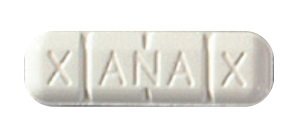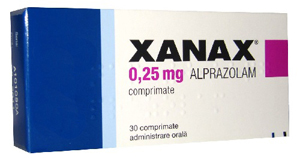Xanax (alprazolam)
Xanax (alprazolam) is a benzodiazepine. Alprazolam affects chemicals in the brain that may be unbalanced in people with anxiety. Xanax is used to treat anxiety disorders, panic disorders, and anxiety caused by depression.
Why is this drug prescribed?
Anxiety Disorders
Xanax Tablets (alprazolam) are indicated for the management of anxiety disorder or the short-term relief of symptoms of anxiety. Anxiety or tension associated with the stress of everyday life usually does not require treatment with an anxiolytic. Generalized anxiety disorder is characterized by unrealistic or excessive anxiety and worry about two or more life circumstances, for a long period, during which the person has been bothered more days than not by these concerns. The following symptoms are often present in these patients: Motor Tension, trembling, twitching, or feeling shaky; muscle tension, aches, or soreness; restlessness; easy fatigability. Autonomic Hyperactivity, shortness of breath or smothering sensations. Palpitations or accelerated heart rate, sweating, or cold clammy hands; dry mouth; dizziness or light-headedness; nausea, diarrhea, or other abdominal distress; flushes or chills; frequent urination. These symptoms must not be secondary to another psychiatric disorder or caused by some organic factor. Anxiety associated with depression is responsive to Xanax.

Panic Disorder
Xanax is also indicated for the treatment of panic disorder, with or without agoraphobia. Studies supporting this claim were conducted in patients whose diagnoses corresponded closely to criteria for panic disorder. Panic disorder is characterized by recurrent unexpected panic attacks, ie, a discrete period of intense fear or discomfort in which four of the following symptoms develop abruptly and reach a peak within 10 minutes: palpitations, pounding heart, or accelerated heart rate; sweating; trembling or shaking; sensations of shortness of breath or smothering; feeling of choking; chest pain or discomfort; nausea or abdominal distress; feeling dizzy, unsteady, lightheaded, or faint; derealization or depersonalization; fear of losing control; fear of dying; paresthesias; chills or hot flushes.
What are the uses for Xanax?
As a short-acting anti-anxiety drug, Xanax acts fast to ease the symptoms of two well-known mental disorders. The Psychopharmacology Bulletin states that an extended-release form of alprazolam, Xanax XR, can help prevent symptoms from these disorders from occurring in the first place, helping individuals who suffer from them to lead more satisfying, productive lives. There are two primary conditions for which this medication is prescribed. The uses of Xanax include anxiety disorders, which can affect both adult sand children. The second is panic disorders, which are associated with anxiety. When taken as prescribed, Xanax (alprazolam) use can help stop episodes of intense, irrational fear or anxiety when they start to occur. Xanax take effect quickly on the central nervous system, calming the brain and nerves by increasing levels of the neurotransmitter gamma-aminobutyric acid in the brain. Xanax is a central nervous system depressant, which means that it also slows down vital functions like breathing and heartbeat.
Reasons to buy Xanax:
Xanax is so popular in USA, for example, because there is a tendency for people to love things that are looked at as a quick-fix. Xanax isn't a long-term medication so you can buy Xanax online when you need it and you get a lot of relief. That can feel great, particularly in a fast-paced world or one that tends to be permeated by concepts of constant exposure to the bad news of the world, stressful jobs and lives that just move quickly.
One of the key considerations to understand why Xanax is so popular is to look at its effects on people when they buy Xanax and use it. Sure, there can be plenty of negative side effects, particularly with long-term abuse, but in the short-term, there can be positive feelings that come from using Xanax. Xanax tends to start acting pretty quickly after a person takes it, and the most desired effects of the drug will usually manifest themselves within about an hour after taking it. Why Xanax is so popular? When taken as prescribed it can calm people down and make them feel relaxed. In some cases, particularly with higher doses, Xanax is popular because it can create a euphoric feeling, although not one that’s as strong as other drugs such as opioids. For people who do suffer from anxiety, it can create a sense of relief to be able to focus on their lives without issues of anxiety or phobias plaguing them. When someone misuses Xanax or combines it with other substances like alcohol, the effects are amplified.
Warnings and Precautions
Xanax use without a prescription, or taking the medication inappropriately, can result in over-sedation, overdose, and death. Like other drugs in the category of benzodiazepines, Xanax can also cause dependence and addiction when used for nonmedical reasons.
Contraindications
For patients receiving doses greater than 4 mg/day, periodic reassessment and consideration of dosage reduction is advised. In a controlled postmarketing dose-response study, patients treated with doses of Xanax greater than 4 mg/day for 3 months were able to taper to 50% of their total maintenance dose without apparent loss of clinical benefit. Because of the danger of withdrawal, abrupt discontinuation of treatment should be avoided. The necessary duration of treatment for panic disorder patients responding to Xanax is unknown. After a period of extended freedom from attacks, a carefully supervised tapered discontinuation may be attempted, but there is evidence that this may often be difficult to accomplish without recurrence of symptoms and/or the manifestation of withdrawal phenomena.

In all patients, dosage should be reduced gradually when discontinuing therapy or when decreasing the daily dosage. Although there are no systematically collected data to support a specific discontinuation schedule, it is suggested that the daily dosage be decreased by no more than 0.5 mg every three days. Some patients may require an even slower dosage reduction. In any case, reduction of dose must be undertaken under close supervision and must be gradual. If significant withdrawal symptoms develop, the previous dosing schedule should be reinstituted and, only after stabilization, should a less rapid schedule of discontinuation be attempted. In a controlled postmarketing discontinuation study of panic disorder patients which compared this recommended taper schedule with a slower taper schedule, no difference was observed between the groups in the proportion of patients who tapered to zero dose; however, the slower schedule was associated with a reduction in symptoms associated with a withdrawal syndrome. It is suggested that the dose be reduced by no more than 0.5 mg every 3 days, with the understanding that some patients may benefit from an even more gradual discontinuation. Some patients may prove resistant to all discontinuation regimens.
Patient medical information for Xanax
Dosage should be individualized for maximum beneficial effect. While the usual daily dosages given below will meet the needs of most patients, there will be some who require doses greater than 4 mg/day. In such cases, dosage should be increased cautiously to avoid adverse effects. Treatment for patients with anxiety should be initiated with a dose of 0.25 to 0.5 mg given three times daily. The dose may be increased to achieve a maximum therapeutic effect, at intervals of 3 to 4 days, to a maximum daily dose of 4 mg, given in divided doses. The lowest possible effective dose should be employed and the need for continued treatment reassessed frequently. The risk of dependence may increase with dose and duration of treatment.
In all patients, dosage should be reduced gradually when discontinuing therapy or when decreasing the daily dosage. Although there are no systematically collected data to support a specific discontinuation schedule, it is suggested that the daily dosage be decreased by no more than 0.5 mg every 3 days. Some patients may require an even slower dosage reduction. The successful treatment of many panic disorder patients has required the use of Xanax at doses greater than 4 mg daily. In controlled trials conducted to establish the efficacy of Xanax in panic disorder, doses in the range of 1 to 10 mg daily were used. The mean dosage employed was approximately 5 to 6 mg daily. Among the approximately 1700 patients participating in the panic disorder development program, about 300 received Xanax in dosages of greater than 7 mg/day, including approximately 100 patients who received maximum dosages of greater than 9 mg/day. Occasional patients required as much as 10 mg a day to achieve a successful response.
Treatment may be initiated with a dose of 0.5 mg three times daily. Depending on the response, the dose may be increased at intervals of 3 to 4 days in increments of no more than 1 mg per day. Slower titration to the dose levels greater than 4 mg/day may be advisable to allow full expression of the pharmacodynamic effect of Xanax. To lessen the possibility of interdose symptoms, the times of administration should be distributed as evenly as possible throughout the waking hours, that is, on a three or four times per day schedule. Generally, therapy should be initiated at a low dose to minimize the risk of adverse responses in patients especially sensitive to the drug. Dose should be advanced until an acceptable therapeutic response (ie, a substantial reduction in or total elimination of panic attacks) is achieved, intolerance occurs, or the maximum recommended dose is attained.
Antidepressants
Sleeping Pills
Anxiety
Depression Basics
Bipolar Disorder
Men Depression
Women Depression
- Depression in Women as a common problem
- Social & Cultural causes of Women Depression
- Female Depression & Suicide
- Why Women Depression is More Common Than Men
- Top 10 Causes of Female Depression
- How Friends & Family Can Help a Depressed Woman
- List of Sources Depressed Women Get Help
- Female Depression Symptoms
- More Female Depression Symptoms
